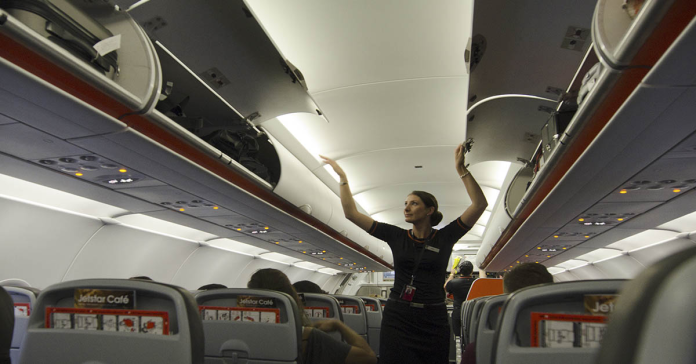In air travel, flight attendants do much more than just serve drinks and make passengers comfortable. They are skilled professionals tasked with maintaining the safety and welfare of all individuals on the aircraft. Among the various procedures they follow, one that may seem unusual is the bracing position the cabin crew assumes during takeoff and landing.

When passengers see flight attendants strapping into their jump seats and placing their hands under their thighs during landings, it often raises questions and curiosity. However, in a viral TikTok video, Cebu Pacific flight attendant Henny Lim clarifies that there’s a specific reason behind this seemingly odd position.
Lim explains that the bracing position consists of several deliberate steps: securely fastening the seatbelt, sitting upright, resting hands on the thighs with thumbs tucked in, keeping the arms relaxed, and placing both feet flat on the floor.

The main purpose of the bracing position is to limit body movement in the event of an emergency, thereby lowering the chances of injury upon impact. By maintaining a firm posture and staying securely seated, flight attendants are better equipped to endure the physical forces of a crash landing.
At the same time, flight attendants carry out what Lim refers to as a “silent review,” mentally running through emergency procedures. This includes recalling how to operate emergency equipment and doors, rehearsing safety commands, and scanning for external visual cues.

Regulatory bodies such as the Federal Aviation Administration (FAA) emphasize the significance of the bracing position. In an FAA memo, it is stated that the position serves two key functions: limiting flailing and reducing secondary impact. Flailing—uncontrolled limb movement during a crash—can result in further injuries, making the bracing position a critical safety measure.
Assuming the bracing position helps reduce the risk of injury. Additionally, positioning the body—especially the head—against the surface it is likely to hit during impact can lessen the intensity of secondary impact injuries.
Henny Lim’s explanation of the bracing position reflects a growing trend of flight attendants using social media platforms such as TikTok to inform passengers about safety procedures and share their personal experiences.
Flight attendant Destanie, for example, has attracted attention by sharing stories about the outrageous behavior some passengers use to try to secure seat upgrades. Although these tales entertain viewers, they also emphasize the need to follow safety rules and respect the professionalism of flight attendants.
Flight attendants like Destanie and Esther Sturrus offer honest reflections on both the challenges and rewards of their career. They recognize the tough aspects, including handling demanding passengers and working under pressure, but they also appreciate the lifestyle and opportunities their profession provides. Despite these difficulties, their commitment to passenger safety stays strong.
The bracing position that flight attendants take during takeoff and landing is far more than just a routine—it’s a vital safety practice designed to reduce the risk of injury in emergencies. Thanks to insights from professionals like Henny Lim, passengers can better understand the reasons behind this procedure and the careful preparation involved in keeping them safe.
As flight attendants keep sharing their knowledge and experiences, passengers become more informed and develop a deeper appreciation for the commitment of those responsible for their safety during air travel.

